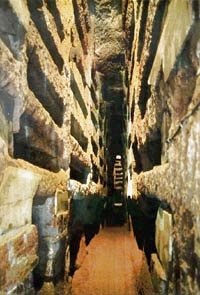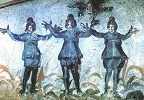Catacomb Art |
Catacomb Art |
 The first Christian art was in catacombs -- underground hallways and small rooms where both Christians and pagans were buried. Although Christians rejected cremation, most burials were in surface cemeteries, since underground burial was only possible where soft rock existed--in Rome, Naples, Syracuse (Sicily). Of the 550 miles of catacombs in Rome, few walls were painted. Pagan artists may actually have painted all the murals since the style is similar, whether depicting Christian or non-Christian themes. Still, the existing paintings are important because they tell us what themes were important to early Christians. Although the catacomb paintings are difficult to date with any certainty, the earliest examples are thought to be from the 3rd century.
The first Christian art was in catacombs -- underground hallways and small rooms where both Christians and pagans were buried. Although Christians rejected cremation, most burials were in surface cemeteries, since underground burial was only possible where soft rock existed--in Rome, Naples, Syracuse (Sicily). Of the 550 miles of catacombs in Rome, few walls were painted. Pagan artists may actually have painted all the murals since the style is similar, whether depicting Christian or non-Christian themes. Still, the existing paintings are important because they tell us what themes were important to early Christians. Although the catacomb paintings are difficult to date with any certainty, the earliest examples are thought to be from the 3rd century.
In general, the paintings are more important for their meaning than for their artistic merit. (They do not compare with Pompeiian frescoes in artistic excellence.) There are few details, no perspective or sense of space, and usually the forms are frontal -- they only depict enough to remind the faithful of the story and its significance.
| The Good Shepherd | |
 |
The image of the good shepherd reoccurs in catacomb painting. It relates to one of the most important themes in these paintings: the theme of deliverance. Recall the 23rd Psalm, in which the shepherd leads the sheep "through the valley of the shadow of death" -- or the parable in Luke 15:4-6, in which the shepherd finds the lost sheep and rejoicing lays it on his shoulder -- or the allegorical theme in John 10:1-18, in which Christ as the good shepherd gives his life for his sheep.
In early Christian art, the shepherd is usually youthful, carrying a sheep on his shoulders -- a common way of carrying wounded sheep. Later, after the 4th century, the shepherd sometimes has the features of Peter, since Peter was charged by Jesus to "feed my sheep." This image for Jesus died out in the Medieval period as people increasingly associated Jesus with the ruler and judge at the Last Judgment.
Like many images in early Christian art, the rendering of this motif owes something to pagan art. Hermes or Mercury had already been depicted in classical art as guardian of the flocks. |
| The Orant [Praying Woman] | |
 |
A common form on sarcophagi as well as on catacomb walls, the orant is a figure for the soul, usually a woman, even if she occurs with a male burial. She represents a Christian in prayer, either praying for deliverance or giving thanks for it. She may also represent the deceased praying for those still living. She is a supreme symbol of faith. Of high artistic quality, this particular painting may be a funerary portrait of an actual person as well. |
| Three Hebrews in the Fiery Furnace | |
 |
Another image of deliverance, this story may have had special relevance for early Christians. Like the three Hebrews who --according to the Old Testament book of Daniel-- had refused to worship the golden image that Nebuchadnezzar had erected, early Christians could have been burned at the stake or thrown to the lions for refusing to worship an image of the Roman Emperor. |
| Jonah Thrown into the Sea | |
 |
The story of Jonah -- yet another deliverance story -- is often repeated in early Christian art. The story is also associated with Christ's resurrection (see Matthew 12:39ff). The artist here has borrowed from pagan art (the Perseus and Andromeda story) in depicting a sea serpent rather than a whale. The Bible's most famous example of deliverance --Moses crossing the Red Sea-- was not painted until later since it takes a very skillful artist to depict a scene with a large number of people. |
| The Raising of Lazarus | |

|
This story, also related to the theme of deliverance, occurs over fifty times in catacomb art. It is not, however, an attempt to illustrate the life of Jesus; early Christians were interested in the meaning of Christ's actions, not biography. Again, the story demonstrates the mighty power of God. |
| Click here to go to a fine web site on the art of the catacombs. | |
All images marked MAS were photographed on location by Mary Ann Sullivan. All other images were scanned from other sources or downloaded from the World Wide Web; they are posted on this password-protected site for educational purposes, at Bluffton College only, under the "fair use" clause of U.S. copyright law.